Composting for Beginners
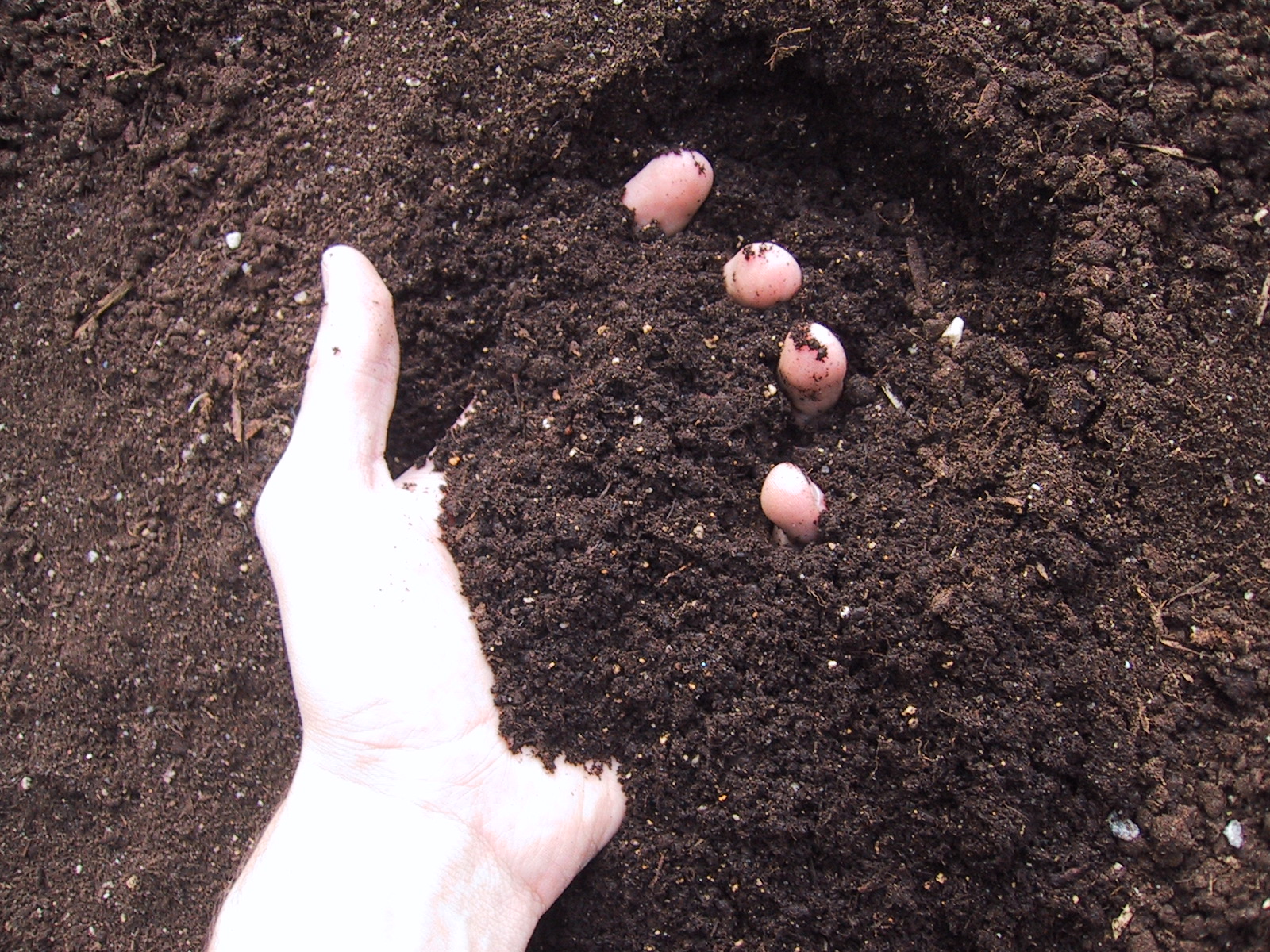
by Victoria Boryca Smith
I am a novice gardener and decided to try composting. It’s frugal and beneficial while speaking to my interest in recycling, reducing waste, saving money and living greener.
- Composting saves money, there is no need to purchase fertilizers or extra soil.
- Composting saves resources, keeping waste out of the landfill.
- Composting improves the soil.
- Composting benefits the environment by reducing methane gas production.
Day 1
I started with a cardboard box with a hole in the top, as ventilation is needed and we wanted a box that would be moveable instead of just a pile in the backyard. I needed a way to collect the kitchen waste and transport it to my compost bin, so I went to a thrift store and found a metal container with a sealing lid and handle.
Day 2
No meat, dairy or animal waste should be composted, as the heat generated in backyard composting is not enough to kill pathogens. Empty egg shells, however, are compostable. I put old vegetables, scraps and coffee grounds in my pail and put it under the sink. I put my cardboard box outside in the backyard under the awning. (Shade is recommended so the compost doesn’t dry out.) I added a bit of newspaper on the bottom, as a mix of brown and green materials is needed for composting. Brown materials are dried leaves, twigs, sawdust, shredded paper and small pieces of cardboard. Green materials are used coffee grounds, egg shells, vegetables, fruits, bread and grass cuttings.
Day 3
I emptied my kitchen pail into my compost box. I added paper napkins from some takeout I had eaten. I trimmed some plants and put the trimmings in a bucket to dry out. They also will be added to the bin later. So far, no one in the family has noticed my composting efforts, though they seemed glad when I told them not to empty their plates in the garbage can. After everyone left the kitchen to avoid work, I added the scraps to my pail.
Day 4
I ordered Chinese food from the cafeteria for lunch. The box is compostable, so I after I ate I put my apple cores and old tea leaves in the box and took it home. I put it in the compost box — easy!
Composting is working — it’s affecting my cardboard box! We switched to heavy-duty milk crates and will go from there.
To be continued next month. . .
Energy Curtailment
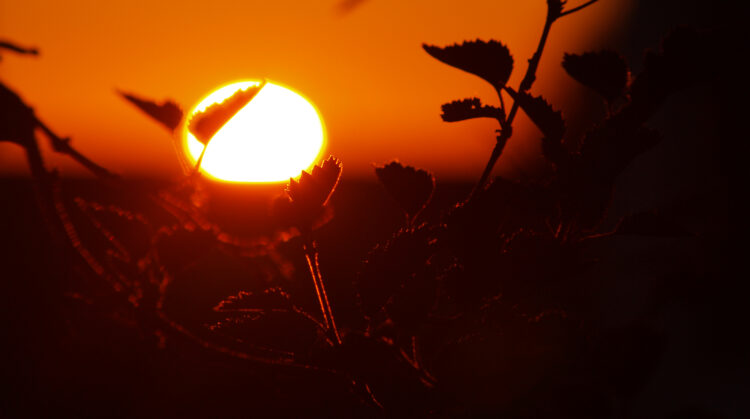
Though summer hasn’t officially arrived, the heat and humidity have, which means we are in energy curtailment.
Energy curtailment allows us to control our maximum energy demand or “peak”. If we can reduce energy where it isn’t needed, we ensure that everything that needs energy is getting it. Lower energy means lower emissions, better air quality, and better health for our community–our mission. It also saves us money as our utility rates are based on peak use. The maximum of energy we use at any given time determines the rate we pay for the entire next year. I can think of many other things to spend money on, can’t you?
In the past many of you felt cold on curtailment days. It seemed backwards, that you would save energy by having it be colder in spaces when it was so hot out. It was an effective way to save energy and money—it’s inefficient to produce heat when it’s hot out, and that’s what we were doing. By not producing that heat, some spaces felt cold.
Updating technology has allowed us to control this process better. Beginning last years, spaces that were previously cold will be affected differently by energy curtailment. They will still be pre-cooled at night. {“Pre-cooling” is a literal term: spaces are cooled in the early morning, before people arrive. This is also when energy use is lower, and before the sun is beating down and temps get really hot. Spaces are often cooled below the temperature set on the thermostat, which makes it easier for the system to keep up, once the heat and humidity are in full effect.} However, these spaces will not need to be pre-cooled to such a cold temp to see the energy savings. This does mean that your space will likely get a little warmer in the afternoon.
Not only does this tend to mirror what happens in a residential situation, it is overwhelmingly what you, the building occupants, have requested and we are happy to report that this is now possible.
We need your help! When we are in energy curtailment, we’ll ask you to help ease the energy load:
- close shades, blinds and curtains whenever possible to reduce solar heat gain;
- lower lighting levels where possible, turn off lights in unoccupied areas and when leaving a room;
- turn off and unplug all electrical equipment not in use (computers, coffee makers, printers, chargers, etc.);
- shut fume hood sashes when not in use; and
- open doors manually instead of using the ADA buttons.
- take the stairs instead of the elevator
- tell others!
These easy steps combine to have a huge impact, on the hot days and for the year ahead.
Earth Month Success
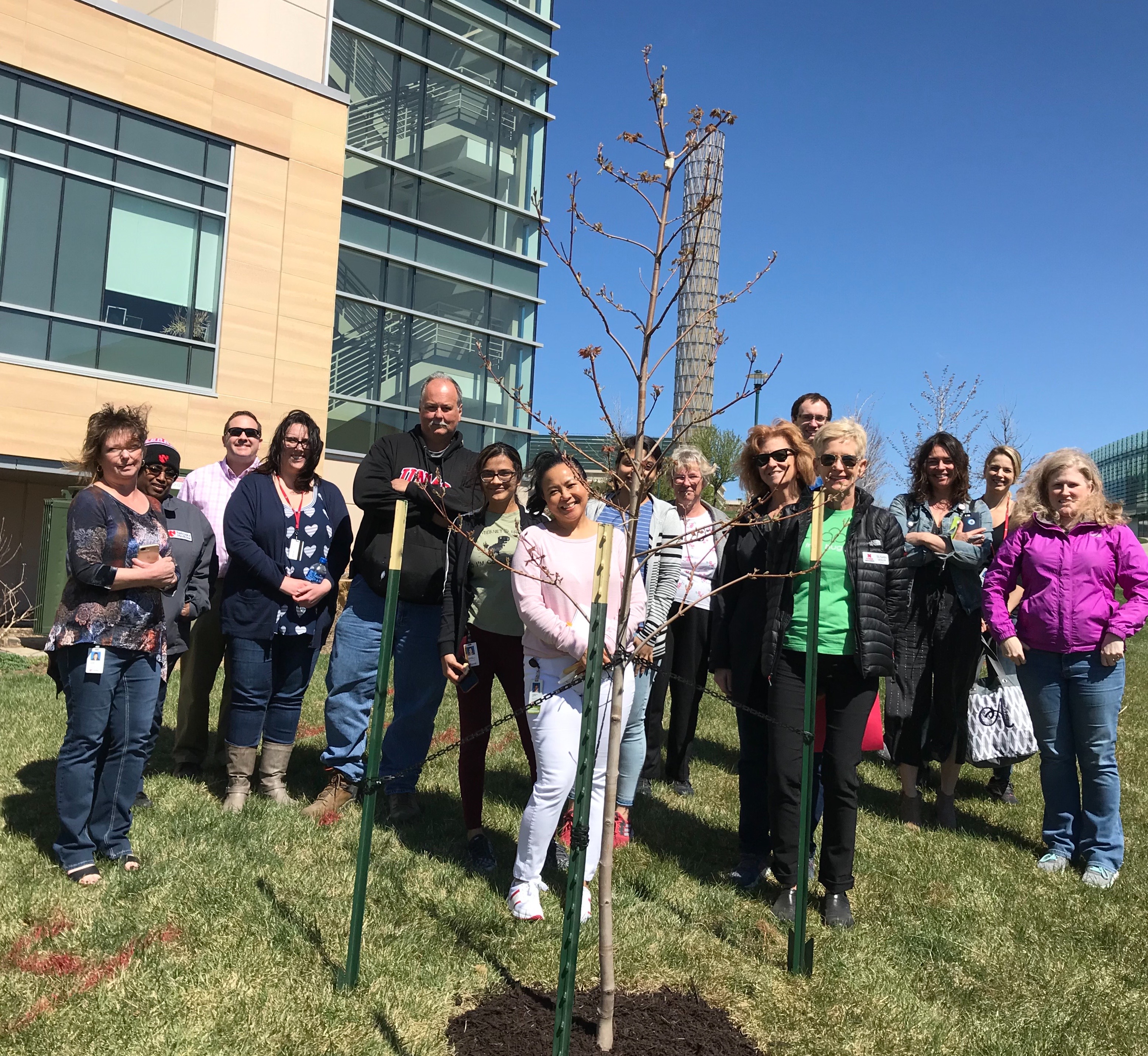
Earth Month has come and gone, but not without some impressive milestones.
We asked you to come up with unique ways to repurpose the library periodical storage containers and you did not disappoint! While everyone provided us with unique ways to reuse, the winners are:
- Jenna Corsey, table
- Euem Osmera, haircare equipment organization/storage
- Laura Strong, diaper/baby care organization
Congratulations! If you missed the entries, check them out here.
To celebrate the 4 BCycle stations on campus we gave away hundreds of free, annual memberships, gave away helmets, and let people test out the new electric-assist BCycles coming soon to a station near you. If you missed the event but would still like a membership, please email LiveGreen@unmc.edu
We maintained our rain-streak during the personal document shredding and electronic/battery/techno trash recycling event, but it’s still our most popular event with hundreds of you dropping off items:
- 261 pounds of VHS tapes, DVDs, CDs, and floppy disks
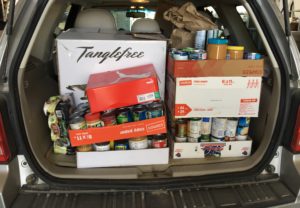
- 14,142 pounds of electronics
- 4,192 pounds of paper for shredding
- 182 pounds of alkaline batteries
- 18,777 total pounds diverted from the landfill. That impact?*
- 24 trees saved
- 255 gallons of oil not used
- 572,686 hours of electricity saved
- 7,752 gallons of water
You also donated:
- 250lbs of food/toiletries and $1,450 to the Maverick Food Pantry
- 161 eyeglasses donated to the TEI clinic; ~2000 pop tabs to Ronald McDonald House
- 6 boxes of books for the Little Free Library!
Peter Pellerito gave a great talk on basic stretches you can do to prevent athletic and repetitive task injuries, and Melanie Stewart presented a zero waste lunch and learn with the COPH and a Re-Imagining U Course on sustainable living.
We celebrated our status as an Arbor Day Foundation’s Tree Campus USA for the 6th straight year by planting an Autumn Blaze Maple giving away Ponderosa Pines and wildflower seeds, and asking Master Gardner Susan Siebler lots of questions.
The Drawdown EcoChallenge allowed many of us to learn new information while having an impressive environmental and personal impact. We placed 77th out of 1,054 teams…and beat UNO’s team. Again!
We want to provide activities that are meaningful to you, both personally and professionally. If you have any additional comments, suggestions, or changes for next year please email us.
*Estimated impact; actual totals may vary slightly depending on the exact mix of electronics and type of paper turned in.
Virtual Water Use
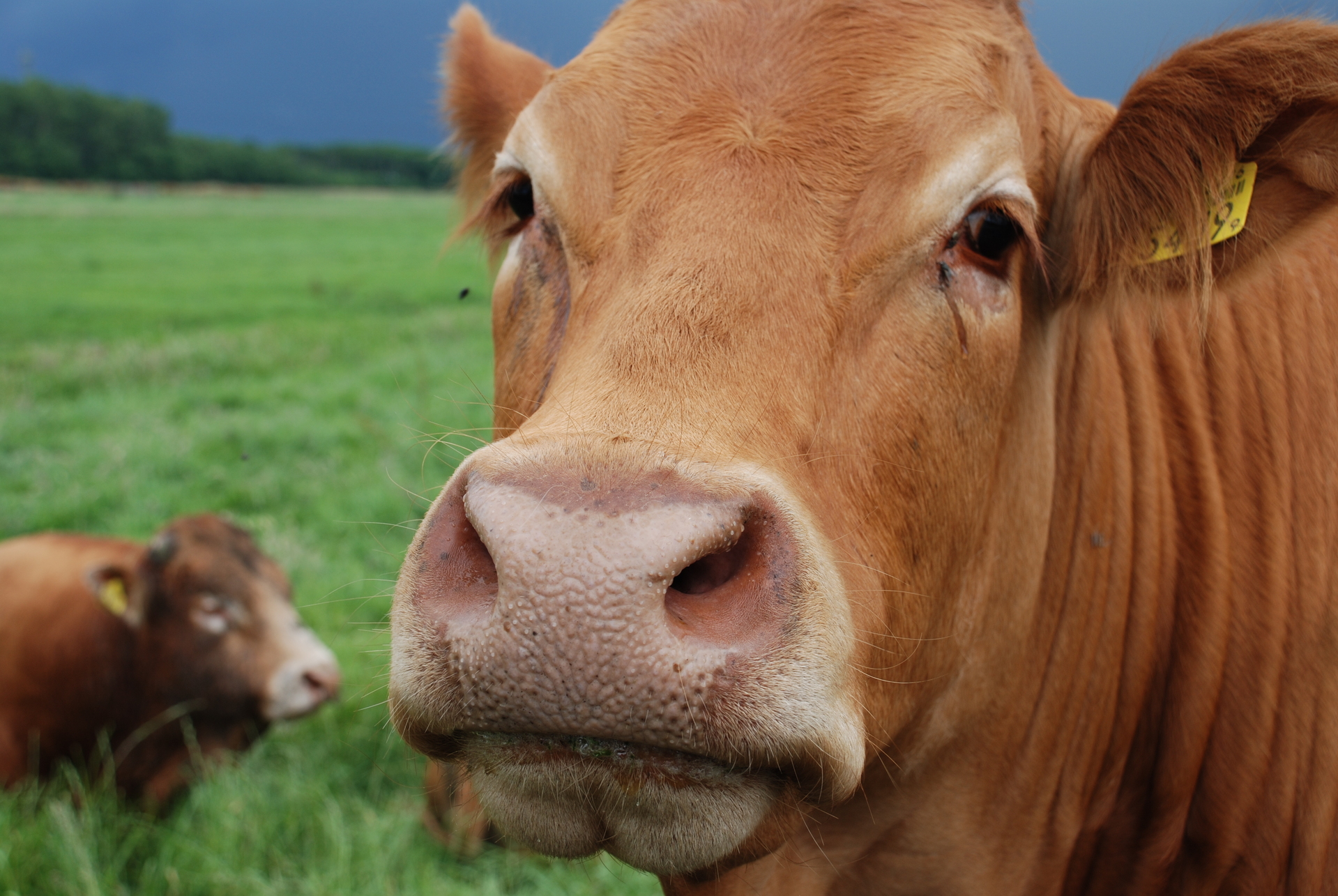
Last week we talked about direct water use (water used to shower, make coffee, water the lawn/plant, etc.) that shows up on your bill. Have you ever thought about the water that is used for you? This “virtual” or indirect water is the amount of water that goes into the other aspects of your life: water used for food, material items, fuel and even electricity. This use doesn’t show up on the monthly bill so most don’t give it a second thought. But there’s a surprising amount of water that goes into everyday tasks, which dramatically impacts our water footprint.
Many of us think about fossil fuels for energy use, but not water. Power plants use water to create steam, which generates energy. We use a lot of energy, which means 41% of all water use went to power generation at a total of 133 billion gallons a day. Fuel for transportation isn’t much better–the U.S. uses up to 2 billion gallons of water a day to refine gasoline products; totaling 3-6 gallons of water used for every 1 gallon of gas (amount depends on fuel type).
Food production uses a lot of water, especially as related to meat. On average, a vegetarian/vegan diet uses half the virtual water as a meat eater. Why? Crops need to be irrigated, the crops grown are fed to animals, animals drink water, and the entire process (crop to your plate) uses a lot of transportation. A cup of coffee actually requires 34 gallons of water to ‘make’, while a serving of beef takes over 650 gallons to get to the table! Generally speaking, eating more plants/less meat reduces water use. Locally grown items use less transportation which also reduces water, making your neighbor’s chicken egg more water efficient than your Columbian coffee.
All of those ‘things’ we buy use water too—growing cotton is water-intensive as is manufacturing, making a common t-shirt/jeans outfit worth ~3,000 gallons of water. Automobiles contains many different materials, so it requires even more—14,000-22,000 gallons each.
We all need to eat and be clothed, so water will always need to be used, but virtual water use demonstrates how important it is to recycle, use active transportation, and eat a healthy diet.
Wondering what your water footprint is? Check out this fun calculator and associated resources, to see where you can have the most impact.
Direct Water Use
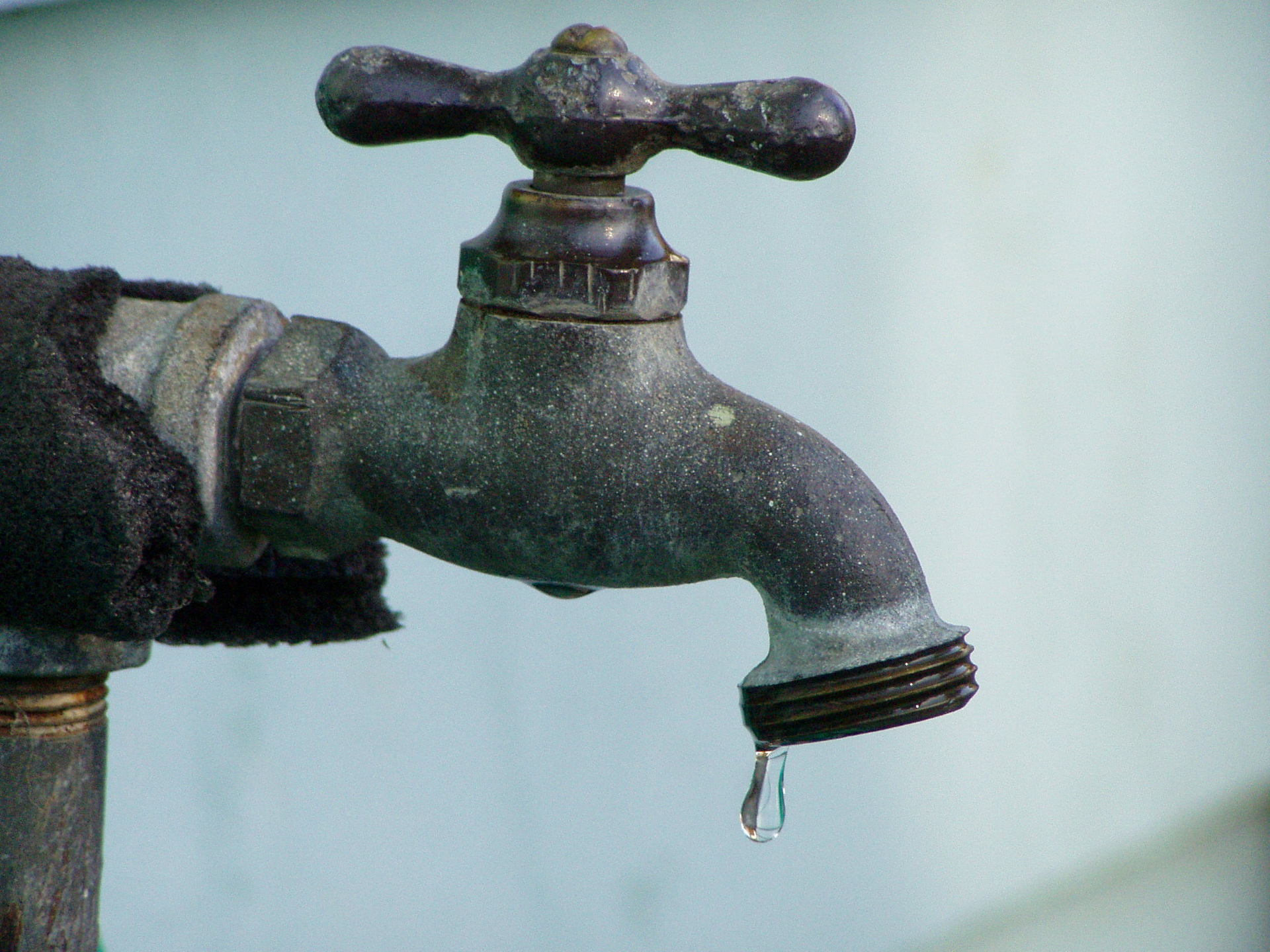
Have you checked out the Every Drop Counts page? You and your fellow colleagues have come up with some great ways to conserve water at home and at work. Everything from reporting drips to FMP to turning the faucet off while cleaning a dish to using water you would have dumped in the sink to water a plant. Check out the list, it’s divided into sections based on the type of work you do and home.
As you hopefully know, LiveGreen has been asking for your help conserving water with our spring campaign. The Med Center has set an ambitious goal to achieve a neutral water footprint by 2030. That means using the same amount of water (or less) than the annual amount that falls on campus as rain and snow. To achieve this goal, the Med Center needs to reduce water use to 104 million gallons per year. Currently we use about 188 million gallons per year. That sounds like a big reduction, but we’ve already made great strides with a 17% reduction from our 2010 baseline of 225 million gallons—and we did that while adding new buildings.
While our water goal was based on being good stewards, as clean water is critical for good heath, this campaign is timely since MUD recently announced rate increases of 19% for commercial water use and 7% for residential customers. Conserving water allows us to put resources to better things, and saves you money at home, too. The more people that conserve water, the bigger the effect, and the better for everyone. While conserving water is important, we will never compromise handwashing technique or other infection control practices.
Anytime you turn on a faucet, water a plant/lawn, or take a shower, you are accounting for your “direct” water use. This is the amount of water that will show on your utility bill at home (or at the med center). It’s the easiest to track and, generally speaking, the easiest way to see an impact. If everyone in your household starts taking a 5 minute shower and you only water your lawn when it needs it, you will see the amount of water used on your monthly water bill go down—along with your cost.
Your lifestyle choices use water in ways you don’t see on your bill. Stay tuned for next week’s article on indirect water use—it’ll shock you!
MyRide OMA Now Available

On Wednesday, Metro unveiled MyRide OMA, a bus tracking website that provides bus arrival information and an upgraded trip planner. Click on the link, select your route and you can see where your bus is in real time. The site will also let you see the bus identification number to make it easier to identify on the street, should your street have multiple routes on it. You can also click on a stop to see which corner of the intersection you need to be at and the time the next 3 buses will arrive, which is updated in real time as well.
Metro is testing website features and asking riders to provide feedback on their experience using it.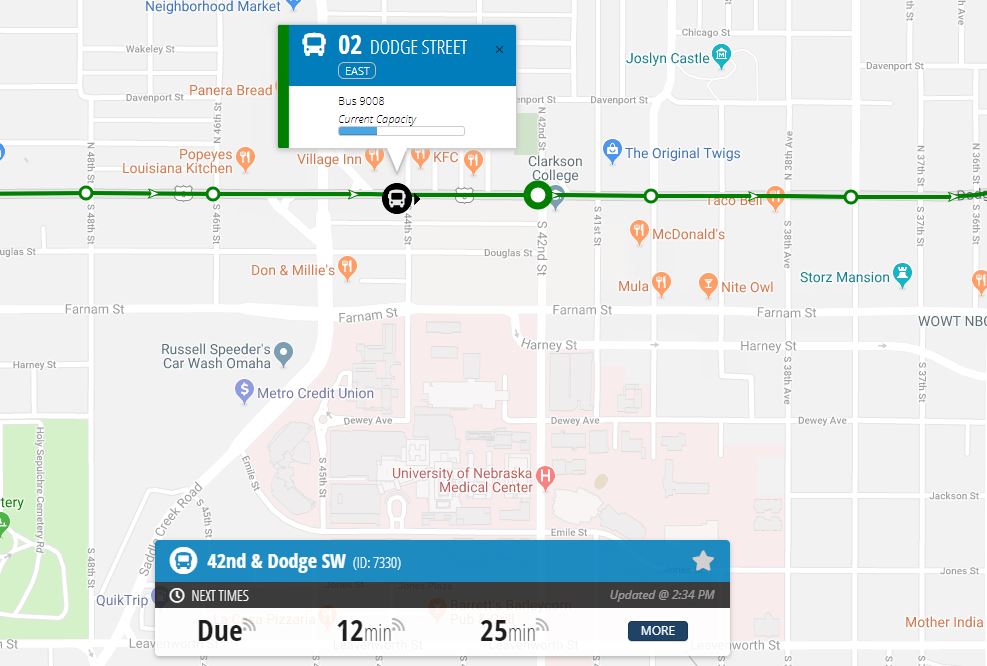
“This system will be great for Omaha and Metro alike. Our riders will have access to real-time information, and we will have valuable data at our fingertips, which will help us make our system more efficient,” said Curt Simon, Metro’s executive director.
There are more features to come, and a mobile app is in development, though the website is mobile-friendly.
“It’s been a long process as we upgrade our fleet, and we’re grateful for our community’s patience and input,” Simon said. “This system is the next step toward better transit in Omaha.”
MyRide OMA accompanies a variety of other improvements for Metro this year, including new buses and paratransit vans, new bus shelters, free onboard Wi-Fi, and ORBT, Omaha’s first rapid transit system.
Don’t forget, all UNMC, Nebraska Medicine, and Clarkson College students and colleagues at the 42nd/Dewey and ECCP locations can commute to and from work on the bus for free as part of TravelSmart. TravelSmart also provides a free emergency ride home if needed, and daily rate flexible parking should you choose to give up your parking permit, which is not required. If you have questions on a route, trip planning, or any aspect of TravelSmart, please email TravelSmart@unmc.edu
Friend of the Environment Award
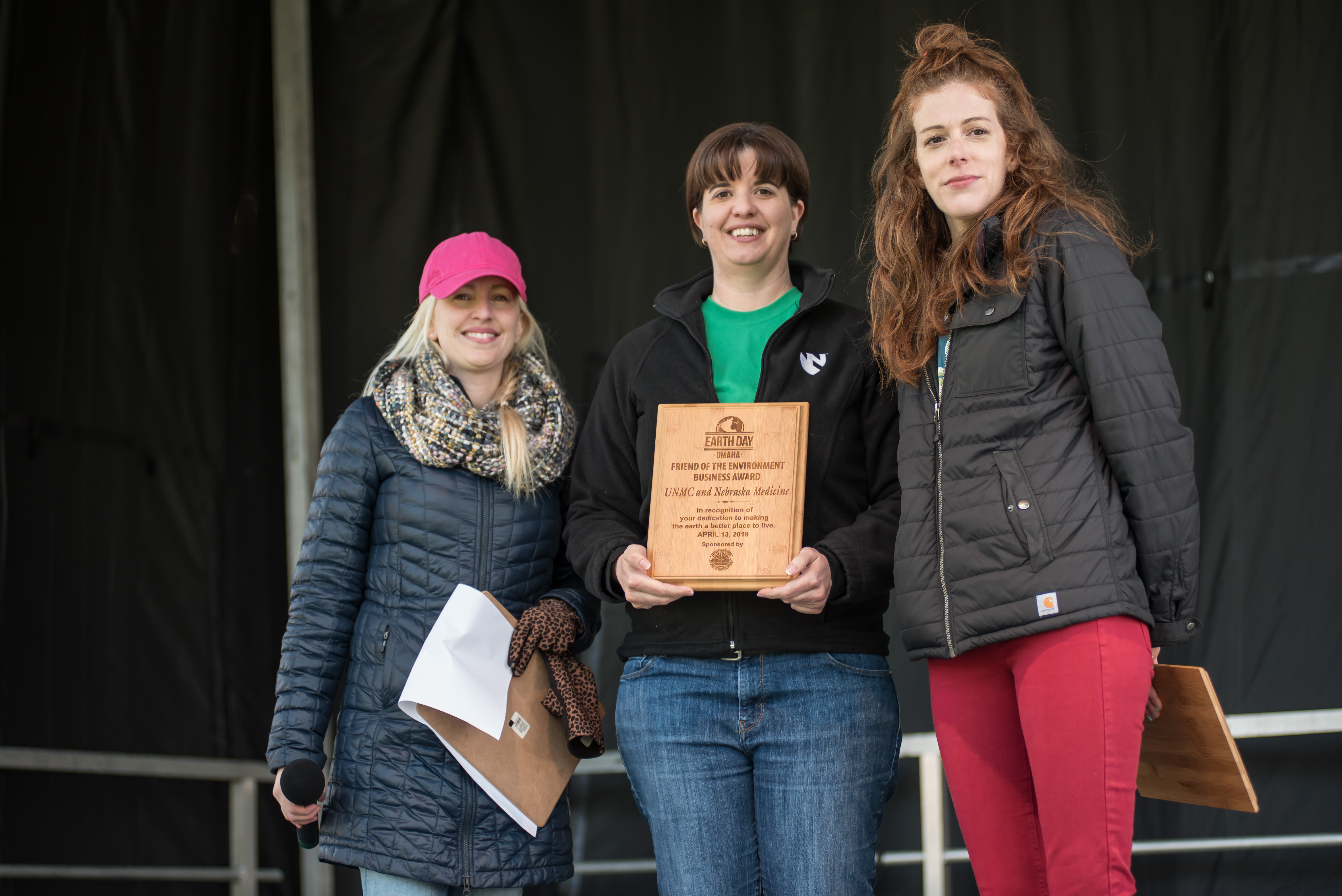
Last Saturday at Earth Day Omaha, UNMC and Nebraska Medicine received the “Friend of the Environment, Business” award by Earth Day Omaha. We are exceedingly proud to accept this award, and thankful for the recognition of sustainability’s connection to health.
Here’s what they had to say about us:
While their work is energy intensive, they have made great strides reducing emissions and improving health by finding ways to dramatically reduce energy use. The reductions in energy from 2010-2017 resulted in more than 251,000,000 kwh not being consumed and not producing 237,338 MTCO2e. This reduction in pollution impacts all of us, but especially those with lung ailments, and can be tied to more than $20M in direct medical costs and associated societal costs and they just installed the largest rooftop solar array in Nebraska.
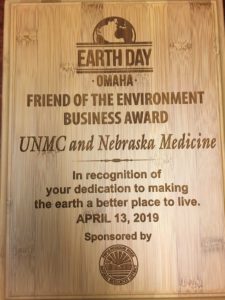
They created TravelSmart–an active transportation program that is free for all students and employees and removes approximately 700 cars a day from the streets, drastically reducing emissions,
and is being replicated by others in Omaha due to its success.
They are continuously working to reduce waste while increasing the amount that is recycled – diverting more than 12 million pounds away from the landfill in the last 9 years.
They have worked to reduce water use and have made reductions of more than 37 million gallons a year while maintaining quality green spaces, planting native plants, installing rain gardens, and being a Tree Campus USA with the Arbor Day Foundation for the 6th consecutive year.
An impressive feat given that they have added more than 1,000,000 sq ft of built space in the same time. They are recognized leaders in this region; not only helping to educate its thousands of students, staff, and visitors but is also driving change in other local businesses. Their impressive ‘2030 goals’ help to drive their success and by providing resources and opportunities to employees/students, it maximizes impact and helps our community in countless seen and unseen ways. They are the only medical center/hospital in the region with these goals and one of only 8 hospitals in the entire country with a Net Zero Emissions goal.
Thank you to the Earth Day Omaha Board for bestowing us with this honor, and to all of the students and colleagues who have changed a habit and helped us to achieve these goals.
Photo credit Rich Watson; from left to right Earth Day Omaha Board Member Sasha Forsen, UNMC/Nebraska Medicine Sustainability Manager Melanie Stewart, Earth Day Omaha Board Member Angie Remington.
Orange Energy Bags
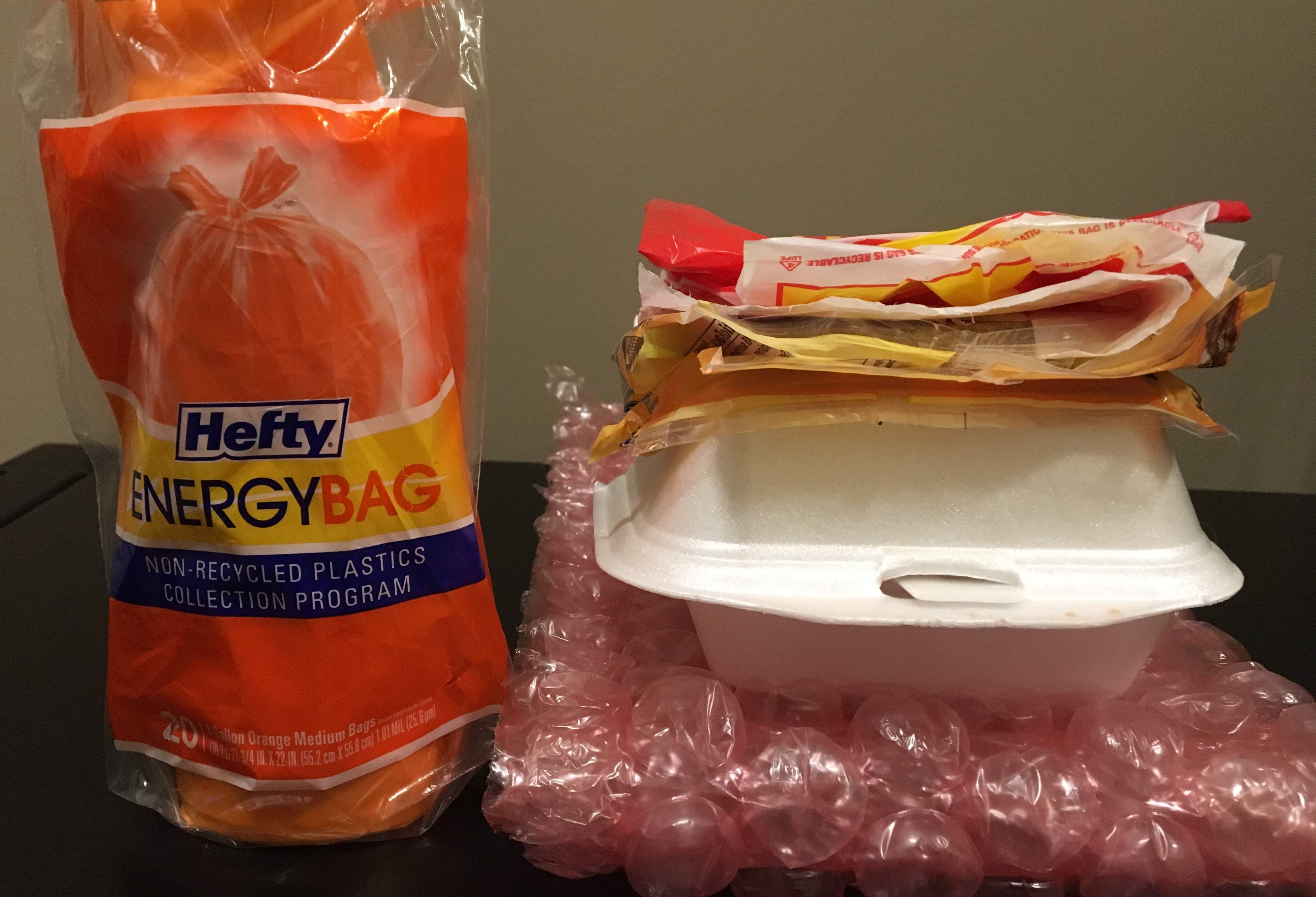
By Tina Spencer
Have you heard of the Hefty ReNew™ program? The consumer buys specific orange bags upfront and can then fill them with soft plastics and poly-products that can’t be recycled currently. This include cereal box liners, straws, bubblewrap, chip bags, protective films, and Styrofoam, just to name a few. The bag is placed in your recycling container, making it easy to segregate from other recyclables at the sorting facility.
We know that single use plastics are a big problem for our landfills and waterways. They are a huge contributor to toxic pollution when burned, producing both carbon monoxide and dioxin, two of the most toxic chemicals on earth.
The program was formally called the “Hefty® EnergyBag® Program” because the intention was to burn the material in the bag, and then use the heat as energy. The creation of energy (which would have been created by burning coal) is a positive, as is diverting the material from the landfill, and removing these items from the current recycling stream—which causes problems.
On the flipside, using fuel to transport them to another state, then burned, which then releases toxins into the air that are then able to be breathed in, is not a positive. Changes have been made and orange bags are now being sent to a different state to a pyrolysis plant, where they are turned into diesel or oil. This is a slightly better process, but in the end it’s still being burnt for energy, it’s just now in an engine.
Ideally, recycling materials into something else that doesn’t cause further harm is the preferred goal and the energy bag program currently doesn’t fit that criteria.
The ReNew® program has promise in the long run. The program has potential to effectively transition from an energy recovery process to a recycling endeavor, but in order for that to happen, investors need to know a volume exists. For more information, read this.
As we work on our Net Zero Waste goal, many have asked why we’re not participating in this program, we certainly have a lot of plastic! Answer: burning plastic/releasing toxins does not meet our mission, and our waste goal states no incineration. However, our volume could help this program and we are looking into safe, appropriate ways to collect and ship it.
Every Drop Counts
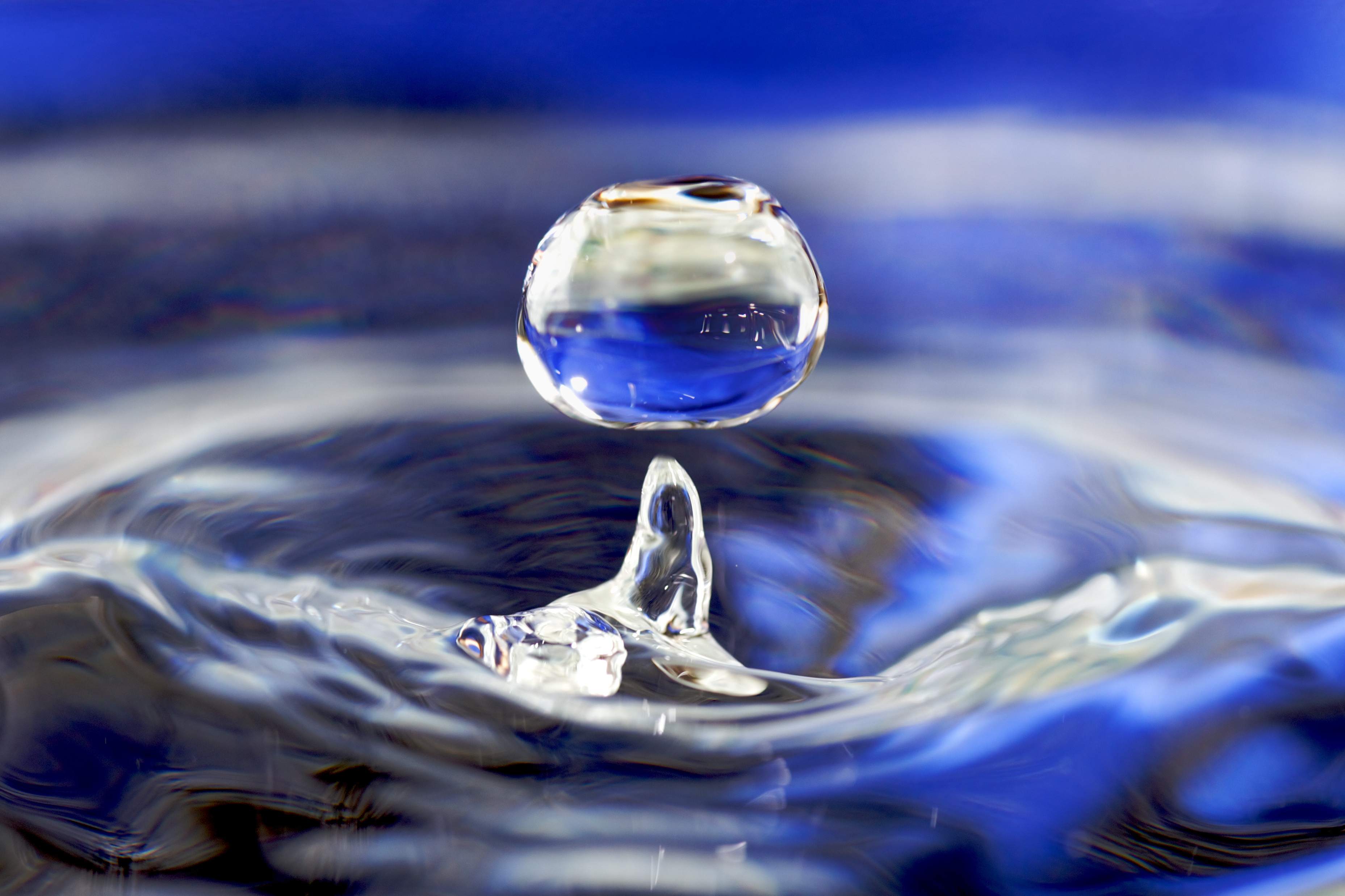
While floods (and snow) continue to ravage our state, it may seem like an odd time to talk about conserving water. People can’t wait for the waters to recede and rebuilding to begin, but water systems are being compromised and our friends and family don’t have potable water to drink. Every drop of water that is wasted is water that could be used to help or conserved to lighten the load on already strained systems. This is true all of the time, but more important now than ever.
LiveGreen is asking for your help conserving water with our spring campaign: Every Drop Counts. As you may know, the Med Center has set an ambitious goal to achieve a neutral water footprint by 2030. That means using the same amount of water (or less) w than the annual amount that falls on campus as rain and snow. To achieve this goal, the Med Center needs to reduce water use to 104 million gallons per year. Currently we use about 188 million gallons per year. That sounds like a big reduction, but we’ve already made great strides with a 17% reduction from our 2010 baseline of 225 million gallons—and we did that while adding new buildings.
While our water goal was based on being good stewards, as clean water is critical for good heath, this campaign is especially timely given the fact that MUD recently announced they will be increasing rates 19% for commercial water use and 7% for all residential customers. Conserving water allows us to put resources to better things, and saves you money.
From now to April 30th, we are asking you to think of ways you can conserve water at work, communicate your actions and ideas to conserve water with your peers, and then use all that apply to conserve water. Please share them with LiveGreen@unmc.edu so we can add them to our site to further spread the word. Even if you think your idea is ‘old news’ or common knowledge, share it! The more people that conserve water, the bigger the effect, and the better for everyone. While conserving water is important, we will never compromise handwashing technique or other infection control practices.
Need some ideas to get started? Check out our Every Drop Counts page and/or get more info on our goal on the LiveGreen water page.
2019 Earth Month Events Announced
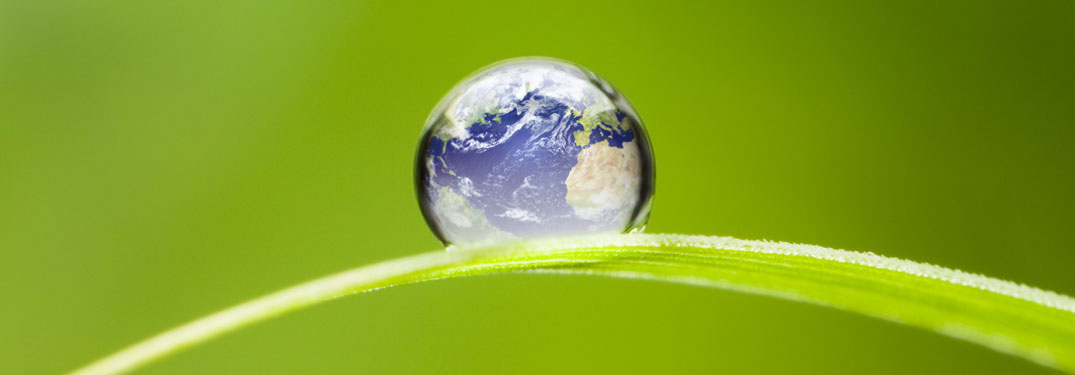
Last year we spread our Earth Day-celebrating events throughout the month, making it easier for you to attend. You said that worked well, so we are doing it again. This year you’ll see a few new events and the return of some favorites:
Want to have an impact without leaving your desk? Join our Drawdown EcoChallenge team! You get to pick the topic area (everything from health to recycling to energy), pick your level of involvement, and you can earn points, win prizes, and make the planet better. Friends and family members are welcome to join our team too.
It wouldn’t be Earth Month without the ever-popular electronic/battery/techno-trash recycling & shredding event for your personal items. As before, we will host this on 2 days at different times to try and help fit a variety of schedules. Almost all items are free, but for costs and details (some of which have changed) please visit our website. We will still be collecting Little Free Library books, pop tabs, eyeglasses, and helping out the Maverick Food Pantry.
We will celebrate Arbor Day on the 19th with a tree planting, tree & wildflower seed giveaway.
The RePurpose It Contest is back—with a twist. Projects must include a periodical storage items no longer being used by the McGoogan Library. Missed the pickup event? We have plenty for you (even if you don’t want to enter the contest), just email LiveGreen@unmc.edu to arrange a pickup.
Join Peter Pellerito for a lunch and learn on stretching. Personal health is important and stretching can help with lots of pains, injury prevention, and keep you moving. Flexibility is within your reach!
Interested in using one of the B-Cycles located around campus…or midtown, or downtown? Join us for I cycle, We Cycle, B-Cycle to get free memberships, free helmets, free refreshments, and you can even try and electric/pedal assist bike.
Last but not least, I’ll be teaching a Re-Imaging U course on sustainable living, and the COPH will host a zero waste lunch on May 1st to learn about going zero waste. We’ll update our page with details ASAP.
We are also going to highlight community events as well as sustainability-oriented Nebraska Scifest events that you and/or your family may be interested in attending. Please see our Earth Month webpage for dates, details, and links to specific information.
See you during Earth Month!
